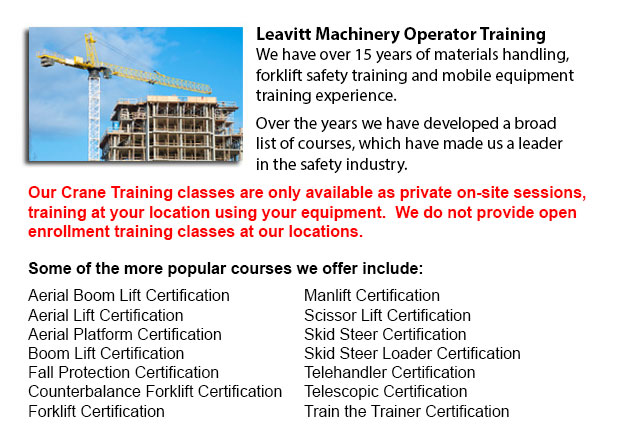
Richmond Hill Overhead Crane Safety Training - Overhead crane safety training equips operators with knowledge and skills about crane safety measures, accident avoidance, materials handling, and machinery and stock protection. Trainees will learn the kinds of overhead cranes, their capabilities and their uses in different industry settings. For operators who are licensed and trained, the shift in liability moves to the operator from the company. Hence, the program emphasizes individual operator tasks.
Overhead crane safety training instructs operators in the right methods for carrying out inspections. Two kinds of pre-shift check are the in-depth inspection and the walk-around inspection. These are vital every day routines that should be logged. Correctly recorded pre-shift inspections help to protect the company from liability in the event of an accident. Pre-shift inspections also prevent damage, costly repairs and accidents. Operators learn how to designate a particular individual to handle inspections, how to maintain the log book and how to report problems.
Every inspection should be documented and carried out regularly. Things which should be inspected for possible problems, comprise: hooks for cracks, increases in the throat opening, degree of twist; hoist ropes for corrosion, loss of diameter, worn wires, kinks and bird caging, broken wires, heat and chemical damage; chains for gouges and nicks, twists, cracks and corrosion, distortion, excessive wear, pits, stretching, damage from extreme heat.
Operators learn right rigging measures in this course. Rigging involves understanding the manufacturer's data plate, determining the material weight to be lifted, choosing the gear, and utilizing safe practices to secure the load. The program cover in detail the following: safe working loads, and the capacities of ropes, chains, hooks, shackles and slings.
It is essential to understand who could operate the cranes at your facility, the job's physical requirements, and operator credentials needed for specialized job and permits. Safety should be prioritized when using in the vicinity of pedestrian traffic.
The duties involved in the safe crane use consists of undertaking visual inspections, checking for hydraulic leaks, checking the safety guards, testing the controls, examining the hook and hoist rope, limit switches and braking mechanisms. Proper reporting procedures are important. These subject matters are all included in depth in the course.
Correct lifting and moving methods with cranes and hoists are covered in the program. Operators would become competent in hand signals. Training involves how to raise the load, attach the load, set the load, unhook the slings and abort a lift.
Moving the load involves a few steps: stopping and starting procedures, controlling and guiding the load, working with signals and observing working conditions. Operators need to know how to proceed in case of a power failure. The course covers methods for lowering the load and removing the slings, parking the crane, storage equipment, and securing an outdoor and indoor crane.
-
Richmond Hill Manlift Operator Training
Richmond Hill Manlift Operator Training - The aerial lift or manlift is a specialized type of hydraulic platform that is meant to lift an individual vertically giving it an alternate name of a vertical personnel lift. These machines are widely used f... More -
Richmond Hill Boom Lift Training
Richmond Hill Boom Lift Training - Aerial platforms or likewise known as elevated work platforms are devices that enable workers to perform tasks and duties at elevated heights which would not be otherwise accessible. There are a variety of aerial li... More -
Richmond Hill Heavy Equipment License
Richmond Hill Heavy Equipment License - A heavy equipment license could be acquired by taking a certification and preparation course at a private training school or a vocational school. This license would qualify you to operate many kinds of heavy ma... More -
Richmond Hill Manlift Training
Richmond Hill Manlift Training - Various manlift training programs consist of the review and content of manlift devices. An important part of the program is the practicum where students show their knowledge and practical ability to safely operate a m... More -
Aerial Lift / Boom Lift / Man Lift / Scissor Lift Training in Richmond Hill
Scissor platform lifts are forklift tables that elevate things and individuals and goods vertically. They are often used in industrial, construction and commercial environments. A common use of scissor platform lifts is for lowering or lifting constr... More -
Richmond Hill Scissor Lift Safety Training
Richmond Hill Scissor Lift Safety Training - A scissor lift is a kind of platform lift that moves vertically. The lift table is moved in a vertical motion because of criss-cross folding supports which are linked in what is known as a pantograph. The... More -
Richmond Hill Heavy Equipment Training
Richmond Hill Heavy Equipment Training - The two most common types of heavy equipment training are classed into the categories of equipment; machines which is fashioned with tracks and those with rubber tires. The tracked vehicle are heavy duty machi... More -
Richmond Hill Loader Operator Certification
Richmond Hill Loader Operator Certification - Why You Must Get A Loader Operator Certification - Certification for forklifts are needed to ensure the safe operation of forklifts for those employers in warehouse, construction and industrial settings.... More

Forklift Certification Richmond Hill
TOLL FREE: 1-888-254-6157
Richmond Hill, Ontario
forkliftcertificationrichmondhill.com
Email Us
About Us


